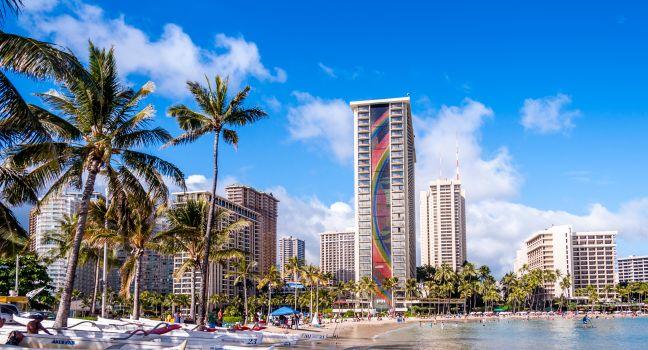Waikiki and Diamond Head

A short drive from downtown Honolulu, Waikiki is Oahu's primary resort area. A mix of historic and modern hotels and condos front the sunny 2-mile stretch of beach, and many have clear views of Diamond Head. The area is home to much of the island's dining, nightlife, and shopping scene—from posh boutiques to hole-in-the-wall eateries to craft booths at the International Marketplace.
Waikiki was once a favorite retreat for Hawaiian royalty. In 1901 the Moana Hotel debuted, introducing Waikiki as an international travel destination. The region's fame continued to grow when Duke Kahanamoku helped popularize the sport of surfing, offering lessons to visitors at Waikiki. You can see Duke immortalized in a bronze statue, with a surfboard, on Kuhio Beach. Today there is a decidedly "urban resort" vibe here; streets are clean, gardens are manicured, and the sand feels softer than at beaches farther down the coast. There isn't much of a local culture—it's mainly tourist crowds—but you'll still find the relaxed surf-y vibe that has drawn people here for more than a century.
Diamond Head Crater is perhaps Hawaii's most recognizable natural landmark. It got its name from sailors who thought they had found precious gems on its slopes; these later proved to be calcite crystals, a much more common mineral. Hawaiians saw a resemblance in the sharp angle of the crater's seaward slope to the oddly shaped head of the ahi fish and so called it Leahi, though later they Hawaiianized the English name to Kaimana Hila. It is commemorated in a widely known hula—A ike i ka nani o Kaimana Hila, Kaimana Hila, kau mai i luna ("We saw the beauty of Diamond Head, Diamond Head set high above").
Kapiolani Park lies in the shadow of the Diamond Head crater, which is just beyond the easternmost limits of Waikiki. King David Kalakaua established the park in 1887, named it after his queen, and dedicated it "to the use and enjoyment of the people." Kapiolani Park is a 500-acre expanse where you can play all sorts of field sports, enjoy a picnic, see wild animals and tropical fish at the Honolulu Zoo and the Waikiki Aquarium, or hear live music at the Waikiki Shell or the Kapiolani Bandstand.
Recommended Fodor's Video
Elsewhere in Honolulu and Pearl Harbor
Chinatown >
Restaurants (9), Things to do (13), Hotels (0)
Downtown Honolulu >
Restaurants (4), Things to do (17), Hotels (1)
Ala Moana >
Restaurants (7), Things to do (11), Hotels (1)
Diamond Head >
Restaurants (0), Things to do (0), Hotels (0)




